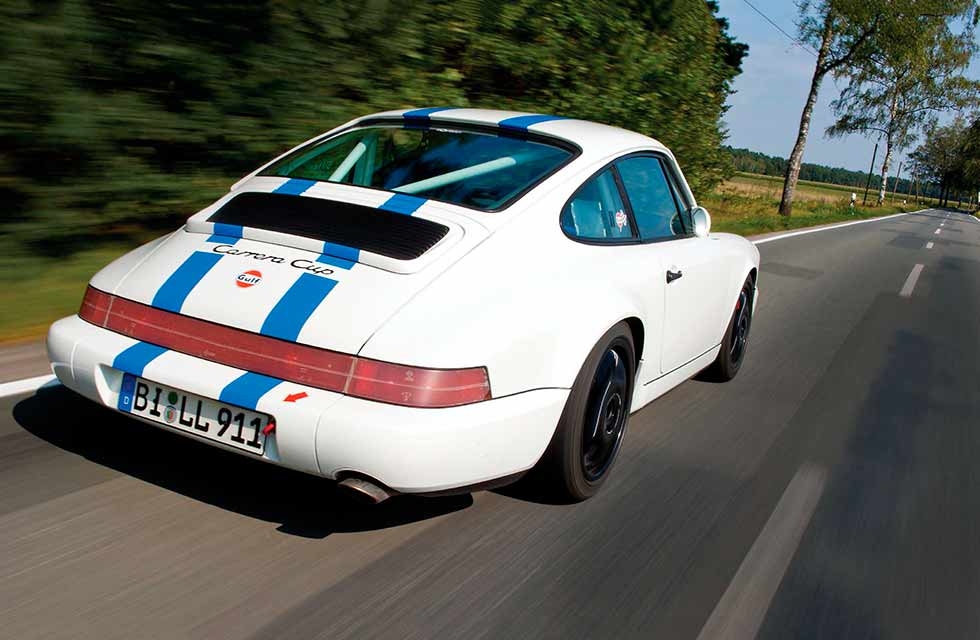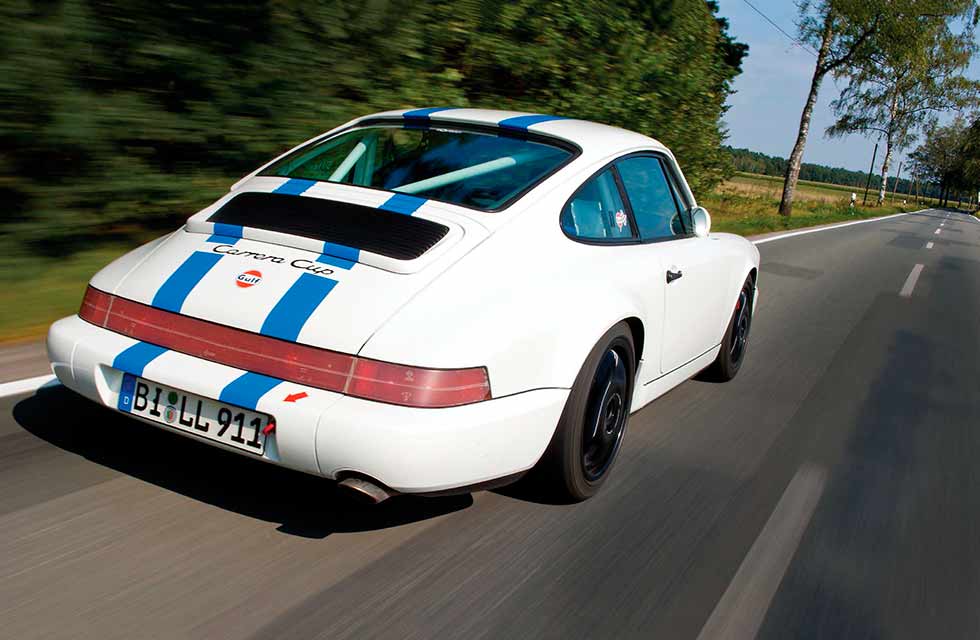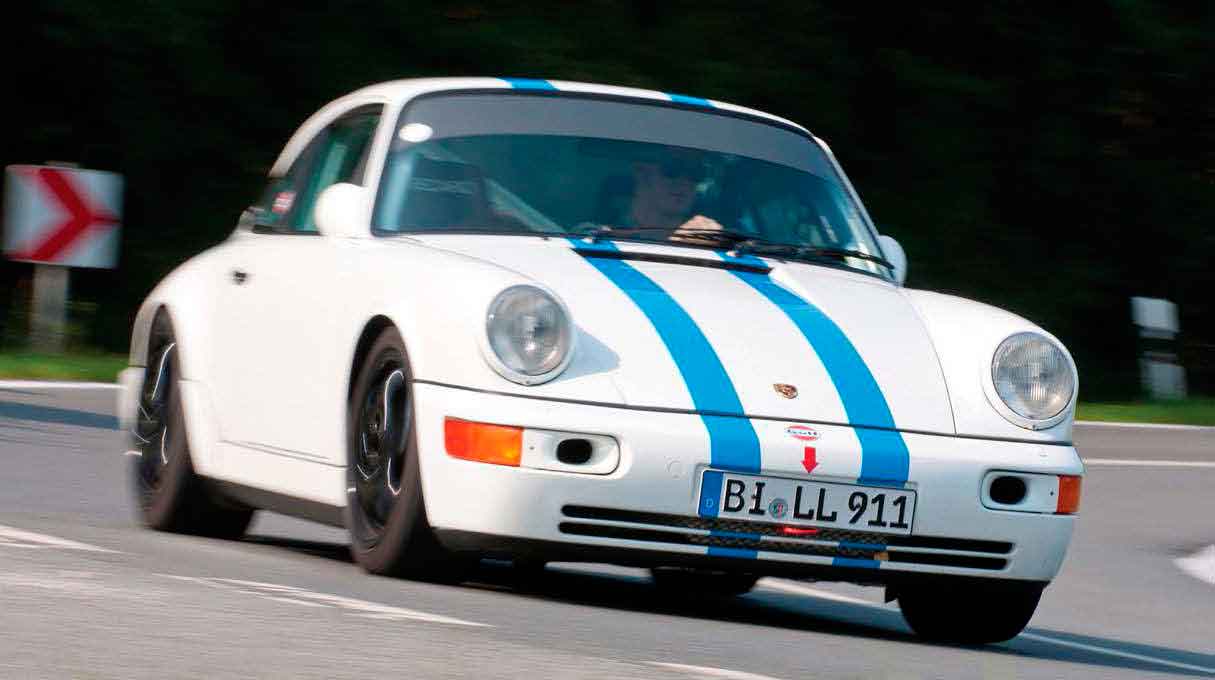
1990 Porsche 911 Carrera Tiptronic Cup Racer 964 – a one-off built by Porsche and raced by Walter Röhrl and now converted for road use, with hand controls for its new owner. The Carrera Cup is an unlikely arena to promote the virtues of automatic transmission, yet in 1990 Porsche built a 964 Tiptronic racing car – and got star wheelman Walter Röhrl to race it at the Nordschleife. Words: Johnny Tipler. Photography: Antony Fraser.
AUTO PILOT 964 TIPTRONIC CARRERA CUP
Hartwig gives me a nudge and indicates the speedo: it reads 260kph. I’ve been too busy gawping at the scenery flashing towards me to pay attention to our actual velocity, but here we are, on the backroads of northern Germany, hitting 150mph. Mollified by his circuit training, plus the full cage surrounding me, I’ve been relaxed enough to appreciate the 964’s pin-sharp handling, its auto shift and racecar rawness. But our pace has inexorably quickened, and this is now something else. My eyes widen and my jaw drops. If ever a demonstration of a car’s prowess grabs the attention, this is it: powering down short, two-lane straights, revs soaring to 7000rpm as the screaming flat-six seamlessly traverses the top three gears, barely lifting for the turns as we catapult from one tree-lined corner to another. Phoah!

It started innocuously enough. A week before, at PCGB’s annual porker fest, snapper Fraser and I were hailed by 964 RS stalwart Des Sturdee, who introduced us to Hartwig Rietz. ‘Did you know Porsche made a Tiptronic racer for the Carrera Cup?’ asked Des. Er, no. ‘Well, they did, and Hartwig owns it!’ I felt a feature coming on. Weissach built 50 cars for the inaugural series in 1990, and fitted one with the brand new Tiptronic semi-auto transmission – chassis 50, the very last. It did just a single race, round 7 of the opening championship, 16th June 1990 on the combined Nürburgring F1 and Nordschleife circuits, piloted by none other than top tester Walter Röhrl.
I also have the race ECU, which makes it shift a little later
Wearing race number 45, Walter started from 6th on the grid. In spite of the obvious differences in drivability of the four-speed semi-auto over a manual car, he still finished 21st out of 30 starters. ‘Walter just brought it home in the middle of the pack, with the disadvantage of the 4-speed ’box and its wide-spread of gear ratios,’ commented Hartwig. Walter was diplomacy personified. His official verdict on the auto: ‘it is good, it is easy, I cannot over-rev the engine; this is the future of road cars, given the intensification of traffic; it’s the future of gearbox technology.’ Off the record, he revealed its shortcomings. ‘It is very hard for me, because I have only four gears, actually just three useable as the first one is too short. I can manage to compensate on a circuit like the Nordschleife, but I was 7 seconds slower than the best Carrera Cup lap time. During practice I was alone so I could carry the speed into corners, but in the race the other cars slowed me down, so after the corners I had no momentum, because with one gear less, the jump in engine revs was too big.’ In a manual Cup car he might conceivably have been 7 seconds ahead of the rest. Fastest lap was 9m 43s, and Walter did a 9m 51sec. It took his legendary talents to compensate For the, er, relaxed nature of the Tiptronic ’box, and that on a circuit he knew backwards.

You might think, why bother – but there was a point to be made. Racing cars with automatic transmission are rare: the Chaparral sports prototypes of the mid-’60s ran semi-auto gearboxes, and Daf’s Variomatic system was an oddball in their little tin-top 33s and Formula 3s in the ’60s, too. Some pro-dragsters are similarly equipped today. But Porsche had a precedent of their own to tilt at: in 1967 Vic Elford, partnered by Hans Herrmann and Jochen Neerpasch, won the punishing Marathon de la Route on the Nürburgring in a 2.0-litre 911R – fitted with Sportomatic transmission. Imagine pounding around the Nordschleife for 84-hours; an automatic shift was a bonus in a race so gruelling that just 13 out of 43 starters made it to the chequered flag. As Vic confirms, ‘it was done to prove that Sportomatic worked big time, and that could then be used as a marketing tool. All three of us loved it. We were doing 7½-hour shifts…at least I was, driving the four consecutive 7½ hour nights, while the other two, in their own words, “did the rest”! Sportomatic made life very easy compared to using a clutch pedal so there were no glitches, and it performed beautifully. To my knowledge, that was the only time it was ever used by the factory in competition.’ Twenty-five years later Porsche needed to establish that the ZF-made Tiptronic ’box could also do the business at the sharp end: their goal was to promote their incoming Tiptronic technology, and where better than the Carrera Cup?
It was a one off. Though entered for another round at the Norisring street-stadium circuit, Porsche didn’t race the car again. Point proven, though Walter was sceptical: ‘the race was only four laps long, so it was not tiring, so the automatic box was no advantage. After the race I told the engineers, “with one gear less than the manual gearbox it is pointless.”’ It needed another ratio to be effective, then, but that was as far as the project went. After a few more Weissach test miles, Hartwig was able to buy it ex-factory. ‘You’re welcome to come over and see it,’ he told us. So, without further ado, we shipped the Frasermobile aboard Stena Line’s palatial leviathan Britannica at Harwich, and made the 200-mile run from Hook-of-Holland to Hartwig’s rural Bielefeld home in four hours. Don’t you just love those unrestricted Autobahns?
As I’ve already implied, Hartwig is not your average driver. And neither is the 964 Tiptronic racer an average Carrera Cup car. Paraplegic from a motorcycle accident in 1989, Hartwig had its controls modified from the outset to suit his physical needs. Hence the second, smaller diameter wheel atop the nifty Carrera Cup steering wheel. That leather-bound ring is his hand throttle, directly linked to the accelerator pedal. He applies the brakes by a lever that protrudes – rather like a column change – from below the steering column. This strut is longer than what’s considered normal for this application, offering superior leverage tension, while deploying a little inset green button allows him to downshift under braking.
Hartwig likes to work and play hard. Till his crippling accident meant he was invalided out of the army, he was an officer in the German Airborne Signal Company, operating from northern Norway to south Turkey as part of NATO´s Allied Command Europe Mobile Force. A classic adrenaline junkie, former paratrooper and sky-diver, though wheelchair bound, he bought a 964 Cabriolet and enrolled on racing courses. Invited to attend a DTM race at the Norisring by his local OPC, he watched practice for the supporting Carrera Cup race, and a certain car emblazoned with the Tiptronic logo caught his eye. A few months later he attended a course overseen by Walter, who of course remembered the 964. ‘If ever that car comes up for sale,’ said Hartwig, ‘be sure to let me know.’
He didn’t have to wait long, and registered it on 25th February 1992. ‘I got it for a fair price,’ he recalls. ‘In those days, the cars cost about 150,000 Dm and I paid about 130,000 Dm. It had just 2400km on the clock.’
However, it wasn’t easy to spring it from Weissach. ‘Each and every department had to sign it off, make sure it had no test parts in it. When I got it, it was street-legal with all the paperwork. The second seat was fitted, there was now a proper fan for the heating system, and they’d removed the switch that would cut off the ABS system if the car spun, and they also took out the big oil pressure warning light. It had the standard ECU for the Tiptronic gearbox, though I also have the race ECU which makes it shift a little later, at higher rpm – this keeps the clutch open in 1st gear to 5000rpm to make a better race start than would be possible with the standard system.’
The front lid is aluminium, and there’s a standard fuel tank and strut brace within. The Cup car wheels are different from the magnesium wheels of the 964 RS; they are half-an-inch wider front and rear, with different offsets, and of different composition with less magnesium. ‘They’re more solid, so you can really have a go!’ They are shod with grippy Marangoni Zeta 255/40 ZR 17 tyres at the back, and 225/45 x 17s on the front.
All Cup cars had blueprinted engines, fitted with specially selected parts: pistons, conrods were weighed and balanced – the engines have special numbers so you can’t confuse a Cup engine with a standard engine. ‘The big difference is the ECU, which provides 25 extra horsepower, and at the top end of the rev range the power delivery is way freer,’ Hartwig explains. ‘It’s got the Cup pipe (instead of the main silencer), and it used to run with an open-air intake, though I’ve fitted a K&N filter and cut-out airbox so it can breathe better.’ Surprisingly, it still has the catalytic converter. ‘They raced with the metal cat in the Carrera Cup,’ Hartwig tells me, ‘which was a novelty in those days; it was a way of showing that racing could be environmentally friendly!’
Inside, the belts are new but the driver’s seat is the one Walter sat in. The Matter rollcage is as you’d expect – a comprehensive network of trusses to brace the internal space. Having adapted the car for his specific use with the hand controls, developed by the late F1 star Clay Regazzoni, Hartwig gradually made his way through the Porsche driving school – from Beginners, to Advanced, and Advanced Nordschleife – and in the process he met Wolf-Hendrik Unger, a Weissach staffer and former co-driver to Roland Kussmaul, who knew the car well and sorted out a few leftovers for Hartwig, including the 964’s all-important Wagenpass. ‘It is like a passport for a race car,’ explains Hartwig. ‘This little piece of paper is the original Porsche document. It shows the chassis and engine number, where it has been raced, who raced it, and it’s a precious part of its history.’ There’s just the one entry, for that Nürburgring round – and that practice run at the Norisring.
By 1997 Hartwig was ready to enter the domestic Club Sport series, and the car has remained relatively unscathed except for the plastic front valance, which has been replaced. Cup cars used the standard rear bumper cladding, unlike the RS with its protruding number plate light housings, and his car’s is undamaged. The door mirrors too are exclusive to the 1990 Cup cars. Back in the day, the brakes were shot after three races. ‘They were not vented, and some drivers were very hard on the brakes,’ he points out. ‘I fitted bigger calipers and GT2 pads, and they are now ventilated by the hose that feeds into the centre of the disc. At Spa, the late Sean Edwards taught me how to get the best out of the brakes. It makes a big difference – short and sharp pressure on the pedal, not too long, and take it easy coming off. They are extremely effective,’ he enthuses: ‘I can show you a picture from 2009 where a 997 GT3 RS tried to outbrake me at the end of Spa’s Kemmel straight and you can see him go into the emergency exit!
It happened in Club Sport, too, when very fast cars like GT2s with 500 horses came up behind me, saw an old car and presumed to blast past it into the chicane – but no way, not under braking.’ He also reveals that his Spa training experience included an involuntary 720-degree spin up the hill out of Eau Rouge towards Raidillon – that had to be some spectacle!
More recently, the car has received its master’s blessing. too. Hartwig had it set up by Porsche specialist tuner and racer Franz Konrad, who ‘played with it until it was absolutely perfect, and that is the way I used it for Club Sport. Then I took this drivers’ course on the Nürburgring GP circuit where Walter Röhrl was an instructor. He recognised the car, and took me for a lap in it for old time’s sake. You cannot learn too much from Walter Röhrl: his driving style is so different. I have seen a few race drivers handle Carrera Cup cars; some are very hard on the steering wheel, really trying to feel the front end by working hard on the steering. But Walter did almost nothing: left foot on the brake, right foot on the gas pedal, using the steering very little because he was totally relaxed, just fingertips, like he was playing a violin. He was very, very fast, and after a few corners he said, “the car is wonderful, I wouldn’t change anything on the sway bars.”’
Twenty years on, it retains its original engine, unrebuilt, with close to 40,000km on the clock, a combination of road use, Club Sport action, and that Nordschleife race. It has pride of place in Hartwig’s garage, which is an integral part of his home, not only for reasons of wheelchair access. So corrosion has never been a problem. There’s been some light customising: as well as the blue race stripes that recall the ’50s Cunningham racers, Hartwig has ‘Jo Siffert Automobiles Fribourg’ decals in the back windows. A fan of Porsche since the 1970s, he had a copy made of the sticker he saw in Siffert’s 917 used in the Le Mans movie: ‘it transports a bit of the spirit of the era,’ he says. He also has copies of the enormous Tiptronic decals from 1990 if ever the need arises.
Hartwig warms the engine up. Lack of a main silencer promotes the characteristic deep-throated 3.6-litre flat-six rumble, and as he drives up the road the sliding scale of the engine note as it goes through the Tiptronic ’box seems peculiar, emanating as it is from a racing car. Now comes my induction into stellar-speed rural travel. Acceleration is relentless and fluid through the ratios. It’s very stiffly sprung with hard damper settings – perfect on a billiard-table circuit, but teeth-chattering on a bumpy back road. The internal cage, making for an even tauter chassis, enhances structural rigidity. There is absolutely no roll, so cornering is beautifully flat, steering very direct. It is staggeringly quick through the bends, and equally neck-wrenching under braking. Hartwig has had 20 years to analyse and hone its behaviour to his liking: ‘on very slow corners you do get some understeer, but in faster corners it is neutral with a little tendency to oversteer at the limit – that’s what 911s do. It fits like a glove, it’s light, direct, without power steering, stiffly sprung, no roll, an engine that pulls with a beautiful sound, and it speaks to the driver. On the road or track, once you’ve found the rhythm it will say, “You’re doing good!” or it will say, “Ooooh, you better slow down and readjust!” He remains smitten: ‘it’s still like the first few months with a new lover: it’s a thrill every time I take it out.’
We peak at 260kph. ‘From then on it takes its time,’ says Hartwig, ‘but it still keeps going up to 280.’ Impressive stuff, but this is more about astonishing handling, grip and power delivery than sheer max-out. Attaining that speed is simply the product of an amazing chassis and powertrain.
It’s my turn now. It feels quite a different animal to the standard C2 I’ve been used to, not only in terms of the special controls and Tiptronic shift, but it’s altogether more spartan, a harsher ride, and deafening on full revs – and you do need the restraint of the full harness under cornering and braking. An awesome proposition on a circuit, no doubt – and imagine being amongst 30 identical cars! For now, this taster will do just fine. As for Tiptronic, I’ll settle for the manual ’box, thanks. And thanks, Hartwig, that was some country outing!
THANKS Stena Line (Harwich – Hook-of-Holland) stenaline.co.uk General Reservations: 08447 70 70 70 [email protected]
No matter what the transmission, the 964’s Carrera Cup race chassis make for a formidable road weapon. Left: Hartwig’s personalised cockpit. Secondary, leather bound wheel, acts as a hand-throttle, while a hand-operated brake lever is situated behind the steering wheel. None of this slows Hartwig down! FAB FIFTY VIN numbers for the 1990 964 Carrera Cup cars ran from VIN ZLS 40 90 01 to ZLS 40 90 50. The Tiptronic car is # 50, VIN ZLS 40 90 50. Some cars are just spoilt! Hartwig’s 964 in comfortable surroundings. For wheelchair access, garage is an integral part of Hartwig’s home. Just one Tiptronic equipped 964 Carrera Cup race car was built for the first round of the German series at the Nürburgring, driven by Walter Röhrl Left: Walter at the wheel and in Nürburgring race. Below: Hartwig at the dual controls






